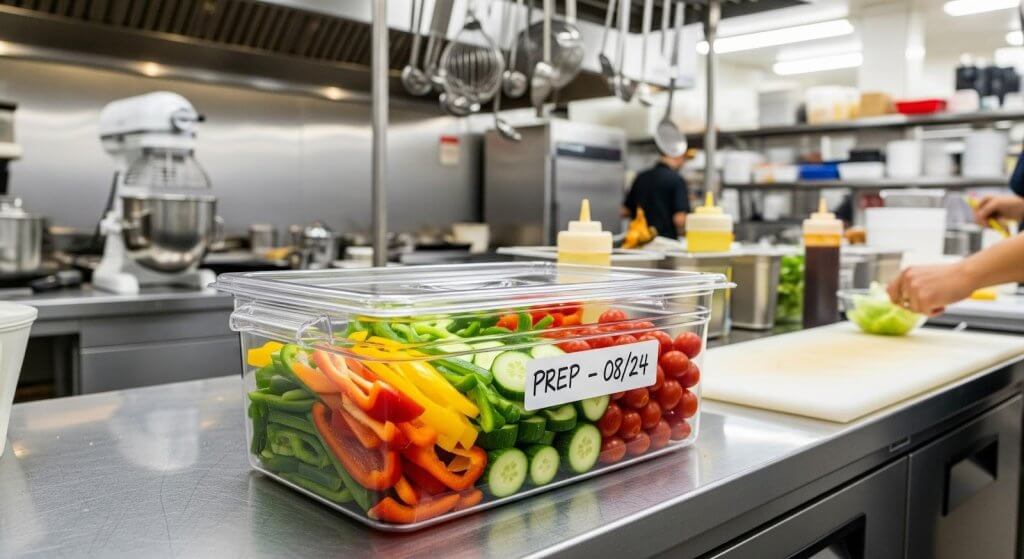The Restaurant’s Backbone: A Storage Strategy for Everything

In a commercial kitchen, chaos is the enemy. The relentless pace of service, the sheer volume of ingredients, and the constant demand for perfect execution leave no room for disorganization. Here, storage is not a matter of tidiness—it’s a critical operational system. It’s the difference between a smoothly flowing service and a catastrophic breakdown. From the delicate life of fresh herbs to the brute force of a commercial mixer, every item demands a specific, strategic home. Building this system requires a forensic understanding of what you store, how you use it, and the relentless pressures of a professional environment.
The Non-Negotiable: Food Safety and Integrity
A restaurant’s reputation hinges on the safety and quality of its food. Storage is the first and most crucial defense. This begins with strict adherence to temperature zones, but the containers themselves are equally vital. Using a dedicated food grade storage box for dry goods like flour and rice prevents pest infiltration and moisture, while clear, airtight deli containers for prepped ingredients ensure quick identification and preserve freshness. Color-coded lids can instantly communicate allergen information or preparation dates to the entire team. This systematic approach isn’t just about compliance; it’s about delivering the chef’s intended flavor and texture to every single plate.
The Engine Room: Workflow and Station Logic
A chef should not be a long-distance runner. Every extra step during service is wasted energy and time. Storage must be engineered around the kitchen’s natural workflow. The cold line needs all salad components, dressings, and cheeses within a single reachable radius. The sauté station requires its oils, wines, and mise en place directly beside the burners. This zonal organization turns a complex dinner service into a series of efficient, localized tasks. Heavy pots live on low shelves near the stove; delicate china is stored on higher shelves away from the fray. The kitchen’s layout should be a map of its daily battle plan.
Protecting Valuable Assets: Equipment and Tools
Commercial kitchen equipment represents a massive capital investment. A stack of expensive non-stick pans becomes worthless when their surfaces are scratched. Chef’s knives are precision instruments that are ruined in a cluttered drawer. Storage must function as a preservation system. Install knife rolls or magnetic strips to protect blades. Use pan racks or individual slots to prevent metal-on-metal contact. For heavy equipment like stand mixers and food processors, dedicated low-boy shelving or under-counter garages provide a secure home that also saves precious prep space.
Maximizing Every Cubic Inch
In a commercial kitchen, space is revenue. Wasted vertical air or inaccessible deep cabinets is a luxury no operation can afford. The solution lies in three-dimensional thinking. Install heavy-duty shelving that reaches the ceiling for bulk dry storage, with a small step stool for safe access. Use rolling carts for backup ingredients that can be tucked away when not in use. Implement vertical plate racks and pan holders to free up entire sections of counter space. Even the space under a prep table can be fitted with shallow racks for sheet pans. Every inch must be assigned a purpose.
The System for Scale and Rotation
A restaurant deals in volume, and its storage must handle constant turnover. This is where systems like FIFO (First-In, First-Out) become physically embedded in the design. Shelving should be angled or arranged to force the use of older stock first. Clear, standardized containers make inventory counts fast and accurate. Storage for cleaning supplies must be completely segregated from food areas, with their own labeled, leak-proof containers. A well-designed system makes the daily grind of restocking and inventory a predictable process, not a nightly chore.
For a restaurant, intelligent storage is a strategic advantage. It reduces food waste, speeds up service, protects valuable assets, and ensures consistent quality and safety. It is the invisible framework that allows creativity and efficiency to flourish under pressure. By designing a storage strategy that is as deliberate as the menu itself, a restaurant builds a foundation for success that is both resilient and adaptable, ready for the relentless, beautiful chaos of service, night after night.
